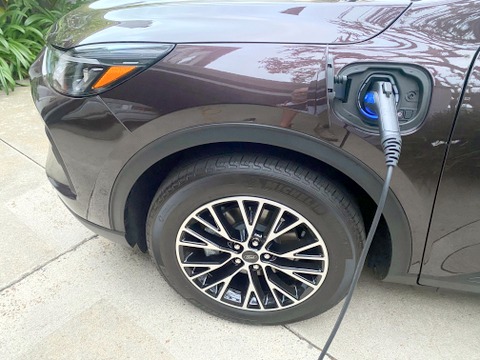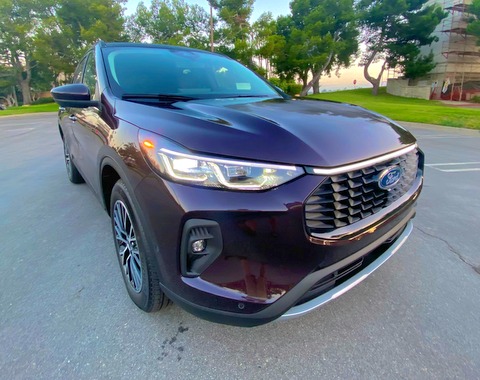The Natural Bridge to an EV
Escaping the High Price of Fuel
The natural bridge from a gasoline-powered car to an electric vehicle is a plug-in hybrid electric vehicle (PHEV). The benefit is being able to drive many miles on pure electricity, and then have “unlimited range” when heading-out on the open road with a fuel-efficient gasoline engine and hybrid system. The 2023 Ford Escape PHEV compact SUV is a fine example of not only being efficient but also versatile.

Electric and Gasoline Power
The 2023 Ford Escape PHEV is powered by a 2.5-liter non-turbo 4-cylinder engine that produces 163 horsepower by itself, but adding in the motor generator that number increases to 200 hp. Running on 87 octane, the front wheels (all-wheel drive is not available) are driven through a continuously variable transmission (CVT) that has five driver selectable drive modes of Eco, Normal, Sport, Slippery and Snow/Sand.

The Environmental Protection Agency rates the all-electric range (AER) at 37 miles and fuel economy at 40 mpg highway and combined when running in gasoline-only mode. That number jumps to 105 MPGe, or miles per gallon equivalent, when combining electricity and gasoline. MPGe is a measurement of how far a car can travel, electrically, on the same amount of energy as is contained in 1 gallon of gasoline.
Clean Fleet Report spent a week driving in Southern California for a total of 179 miles, averaging 48.2 miles per gallon combined gasoline and electricity. We twice topped-off the battery and were able to first go 39 and then 41 miles on pure electricity.
We were able to go further than the 37 AER by staying off freeways and driving close to the posted speed limits while negotiating stop-and-go city driving. The regeneration on the Escape PHEV replenishes the battery when slowing or braking and is what contributed to that excellent all-electric range.
The 2023 Escape has four engine choices, including the plug-in hybrid which we drove. Two gasoline engines—a 1.5-liter 3-cylinder and a 2.0-liter 4-cylinder EcoBoost engines (which in Ford-speak means they are turbocharged) are available. Rounding out the propulsion options, the 2.5-liter Hybrid use both gasoline and electricity, but doesn’t plug in. Only the Escape PHEV does not have all-wheel drive either standard or as an option.
Getting Started

The start/stop ignition button is conveniently located just above the rotary gear selector wheel. When the 14.4 kWh battery is charged, there is no sound upon pressing the start button as the Escape PHEV defaults to electric mode. If it is cold outside or the battery charge is low, then the engine kicks-in as it does under heavy acceleration.
In addition to the above drive modes, there are four power modes designed to maximize the efficiency of the Escape PHEV.
- Auto EV mode allows the computer to decide if the vehicle runs on gasoline or electricity.
- EV Now mode lets drivers operate on all-electric power when available.
- EV Later mode gives drivers the option to drive in full gas-hybrid and conserve a certain percentage of electricity for later use.
- EV Charge mode charges the battery while driving, generating electric-only miles.
Charging
The Escape PHEV uses regenerative braking, which converts kinetic energy into electric energy and stores it in the battery when applying the brakes or coasting. For increased recharging, there is an “L” button on the gear selector wheel.

In addition to the regenerative charging, the lithium-ion battery is replenished by plugging into a charger or wall outlet. Charge times from an empty battery are:
Level 1 – 120V – 10-12 hours
Level 2 – 240V – 3.5 hours
The Escape PHEV does not accommodate 480V fast-charging.
Hitting the Road
Whether you’re using the Escape PHEV for in-town errands, short commutes or on the open road, the ride and ease of driving will make the time behind the wheel a pleasant experience. The drive and power modes described above present several options for tailored driving. If you want extra oomph, select the Sport mode where we were able to get 0-60 mph times of 8.3 seconds. Normal mode is for around town, Eco when on long stretches of open highway for maximum efficiency, and Slippery and Snow/Sand are self-explanatory.

The Escape PHEV has good grip with the Michelin Primacy 225/60 all-season tires, mounted on 18-inch machined magnetic alloy wheels. The steering was on the heavy side, which we liked for the solid feel it gave the Escape’s 3,904 pounds. While some SUVs have numb steering, reducing road feel, this was not the case with the Escape PHEV. There never was time or situation where we felt disconnected from the tires and the road, including around sweeping turns.
While not designed nor marketed as a sports crossover, the handling was solid, but not exciting. We did not get the chance to drive in the rain, but our history with front-wheel drive vehicles is they track well, take corners with confidence and provide good traction in wet conditions. The Slippery drive mode may assist when it gets wet while the Snow/Sand mode probably is greeted with a smile when needed. As noted above, the 2023 Escape is offered with all-wheel drive, just not in the plug-in hybrid model.
Exterior
The Escape PHEV takes design cues from crossovers sold in European markets, having a smooth front end with an appropriately sized grille and no unneeded lower fascia scoops. Amko Leenarts, director, Ford Design says “Not every customer wants a rugged and boxy SUV, so

we’ve made the new Escape more energetic, confident and sleeker.”
The almond-shaped LED reflector headlamps meld into the fenders that lead to smooth sides, sans chrome and cladding. LED tail lights and a very small “PLUG-IN HYBRID” badge on the lower right corner make up the details of the rear, foot-activated power lift gate. The bumper, with a flat top and a skid-resistance surface, incorporates dual exhaust tips.
The Escape PHEV has seven exterior color options—Oxford White, Agate Black, Iconic Silver, Carbonized Gray, Vapor Blue and Atlas Blue. For an extra $495, the head-turning Cinnabar Red Metallic on our test Escape PHEV is available.
Interior
The Escape PHEV has three screens—the fully digital 12.3-inch instrument panel with large power and speedometer gauges, the 13.2-inch capacitive infotainment touchscreen, and the head-up screen. The infotainment screen, with swipe and zoom, was home to the AM/FM HD radio, wireless Apple CarPlay, Android Auto, and SiriusXM.

All of the infotainment and communication goes through the Ford Sync 4 system. FordPass Connect offers convenience features such as remote locking and unlocking of the doors, and starting the engine. The 4G LTE Wi-Fi hotspot can accommodate up to 10 devices, extending as far as 50-feet away. In the interest of keeping the driver’s eyes on the road, Clean Fleet Report would have liked to see a channel selection knob accompany the volume knob on the infortainment display.
What did aid driver inattention was a pop-up customizable head-up display and the heated/leather-wrapped steering wheel’s multiple buttons and toggles to operate the adaptive cruise control, telephone, radio and voice activation functions.
Our Escape PHEV with the Premium package had leather-trimmed seats with the driver getting a heated 10-way power adjustable seat with lumbar and memory, while the passenger gets 6-way power adjustments.
Backseat passengers will appreciate the sliding and reclining rear seat that provides 38.9-inches of rear leg room. Head and shoulder room is good, the fold down center armrest has cup holders, and there are ventilation vents and power ports in the rear of the center console. The 60/40 folding rear seat opens up 63.2-inches of cargo space when dropped.
Interior Convenience
Standard Interior Features
Auto hold, remote start, a rear view camera, compass, dual zone automatic climate control, tilt and telescoping steering column, height adjustable front seatbelts, roof rack rails, active grille shutters, 12-volt power, and USB A and C data and power ports.

Premium Package: $4,530
- Panoramic vista roof
- Head-up display
- Ambient interior lighting
- 360-degree camera with split view and front and rear washers
- Auto-dimming rearview mirror
- Leather trimmed, quilted and perforated seats
- 10-way power driver seat with seat and exterior mirror memory
- 6-way power passenger seat
- Rain-sensing front windshield wipers
- Wireless phone charging
- Front parking sensors
- Reverse brake assist
- Active park assist
- Bang & Olufsen 10-speaker sound system with subwoofer
- HD Radio
Ford’s Co-Pilot360 driver-assist feature is standard and includes blind spot with cross traffic alert, lane keep alert and assist, pre-collision assist with automatic braking, rear pedestrian detection, forward collision warning and a post-crash alert system.
The 2023 Escape PHEV has an extensive list of standard and optional safety features in the Personal Safety System, including front, knee, side and side curtain airbags as part of the Ford Safety Canopy. Additional safety systems include an anti-theft engine immobilizer, tire pressure monitoring system, and front and rear parking sensors.

Pricing and Warranties
The 2023 Ford Escape PHEV comes in one trim but with several options and packages. Including the mandatory $1,495 destination and delivery fee, the base MSRP is $39,995. Clean Fleet Report’s tester had $6,820 in options and packages, and the destination fee, for a total of $46,815.
The 2023 Ford Escape PHEV comes with these warranties.
- Hybrid System – Eight years/100,000 miles
- Powertrain – Five years/60,000 miles
- Bumper-To-Bumper – Three years/36,000 miles
- Roadside Assistance – Five years/60,000 miles
Observations: 2023 Ford Escape PHEV
If you were to plug-in the 2023 Ford Escape PHEV overnight, every night, that daily fully charged battery (37 miles) would be good for 13,500 miles of all-electric driving annually. You can do the math on how much money you would not be spending on gasoline.

As of October 7 (when this was written), the national average price of a gallon of 87 octane was around $3.75. But in California, it was averaging $5.88 per gallon (that’s more than $2,000 to travel those 13,500 miles), so the savings would be even more substantial. However, it isn’t only the savings, but the satisfaction of driving past gasoline stations as you go about your daily routine knowing the Escape PHEV is reducing the need for imported oil.
Ford has announced the Ford Escape will be discontinued after the 2025 model year. This is tough to hear as the Escape has been very important to Ford’s vehicle mix and its sales cannot be understated. The compact SUV segment is fiercely competitive with at least one model from every major manufacturer. For shoppers seeking a plug-in hybrid compact SUV there are a growing list of options, including the segment-leading Toyota RAV4 Prime, the Hyundai Tucson PHEV, Kia Sportage PHEV, Mitsubishi Outlander PHEV, Dodge Hornet PHEV and Jeep Wrangler 4xe. The Chevrolet Equinox has an all-electric model coming out.
So why would Ford stop making a successful and popular vehicle like the Escape? And, in the interim, Ford has its more aggressively styled Bronco Sport compact SUV based on the Escape platform that is selling well. But the big picture tells a simple story – Ford expects 40% to 50% of its global vehicle volume to be fully electric by 2030.
Ford will be launching 40 new battery electric SUV, van and truck vehicles by the end of the decade, which gives hope the Escape PHEV will be replaced with something even better, possibly one that does not need any gasoline to propel it down the road.
Make sure to opt-in to the Clean Fleet Report newsletter (top right of page) to be notified of all new stories and vehicle reviews.
Story and photos by John Faulkner.
